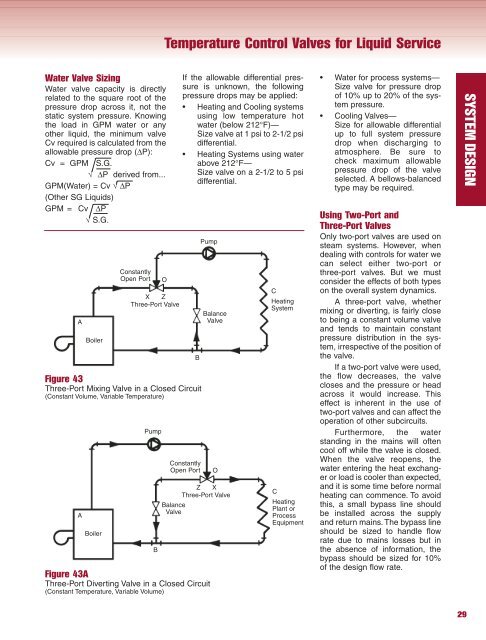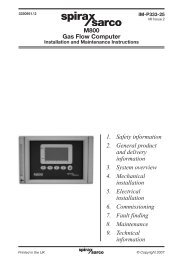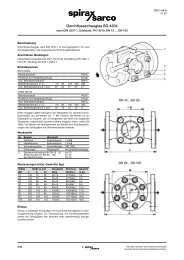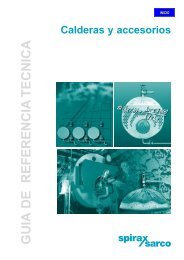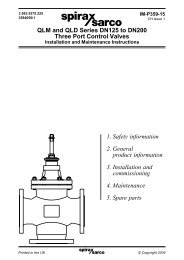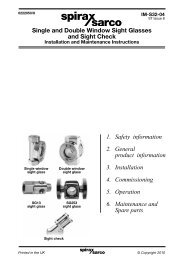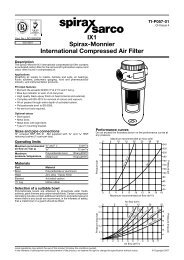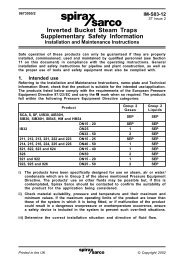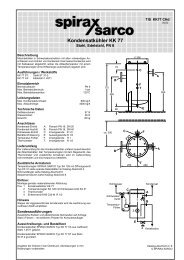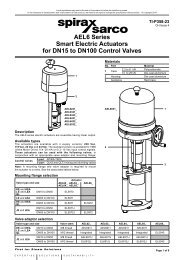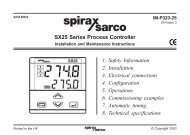2000 Hook-up Book - Spirax Sarco
2000 Hook-up Book - Spirax Sarco
2000 Hook-up Book - Spirax Sarco
You also want an ePaper? Increase the reach of your titles
YUMPU automatically turns print PDFs into web optimized ePapers that Google loves.
Water Valve Sizing<br />
Water valve capacity is directly<br />
related to the square root of the<br />
pressure drop across it, not the<br />
static system pressure. Knowing<br />
the load in GPM water or any<br />
other liquid, the minimum valve<br />
Cv required is calculated from the<br />
allowable pressure drop (∆P):<br />
Cv = GPM S.G.<br />
√ ∆P derived from...<br />
GPM(Water) = Cv √ ∆P<br />
(Other SG Liquids)<br />
GPM = Cv ∆P<br />
√ S.G.<br />
A<br />
Figure 43<br />
Three-Port Mixing Valve in a Closed Circuit<br />
(Constant Volume, Variable Temperature)<br />
A<br />
Boiler<br />
Boiler<br />
Constantly<br />
Open Port<br />
Pump<br />
Figure 43A<br />
Three-Port Diverting Valve in a Closed Circuit<br />
(Constant Temperature, Variable Volume)<br />
B<br />
Temperature Control Valves for Liquid Service<br />
O<br />
X Z<br />
Three-Port Valve<br />
If the allowable differential pressure<br />
is unknown, the following<br />
pressure drops may be applied:<br />
• Heating and Cooling systems<br />
using low temperature hot<br />
water (below 212°F)—<br />
Size valve at 1 psi to 2-1/2 psi<br />
differential.<br />
• Heating Systems using water<br />
above 212°F—<br />
Size valve on a 2-1/2 to 5 psi<br />
differential.<br />
B<br />
Constantly<br />
Open Port<br />
Pump<br />
Balance<br />
Valve<br />
O<br />
Z X<br />
Three-Port Valve<br />
Balance<br />
Valve<br />
C<br />
Heating<br />
System<br />
C<br />
Heating<br />
Plant or<br />
Process<br />
Equipment<br />
• Water for process systems—<br />
Size valve for pressure drop<br />
of 10% <strong>up</strong> to 20% of the system<br />
pressure.<br />
• Cooling Valves—<br />
Size for allowable differential<br />
<strong>up</strong> to full system pressure<br />
drop when discharging to<br />
atmosphere. Be sure to<br />
check maximum allowable<br />
pressure drop of the valve<br />
selected. A bellows-balanced<br />
type may be required.<br />
Using Two-Port and<br />
Three-Port Valves<br />
Only two-port valves are used on<br />
steam systems. However, when<br />
dealing with controls for water we<br />
can select either two-port or<br />
three-port valves. But we must<br />
consider the effects of both types<br />
on the overall system dynamics.<br />
A three-port valve, whether<br />
mixing or diverting, is fairly close<br />
to being a constant volume valve<br />
and tends to maintain constant<br />
pressure distribution in the system,<br />
irrespective of the position of<br />
the valve.<br />
If a two-port valve were used,<br />
the flow decreases, the valve<br />
closes and the pressure or head<br />
across it would increase. This<br />
effect is inherent in the use of<br />
two-port valves and can affect the<br />
operation of other subcircuits.<br />
Furthermore, the water<br />
standing in the mains will often<br />
cool off while the valve is closed.<br />
When the valve reopens, the<br />
water entering the heat exchanger<br />
or load is cooler than expected,<br />
and it is some time before normal<br />
heating can commence. To avoid<br />
this, a small bypass line should<br />
be installed across the s<strong>up</strong>ply<br />
and return mains. The bypass line<br />
should be sized to handle flow<br />
rate due to mains losses but in<br />
the absence of information, the<br />
bypass should be sized for 10%<br />
of the design flow rate.<br />
29<br />
SYSTEM DESIGN


